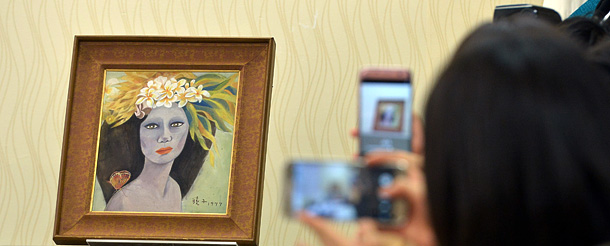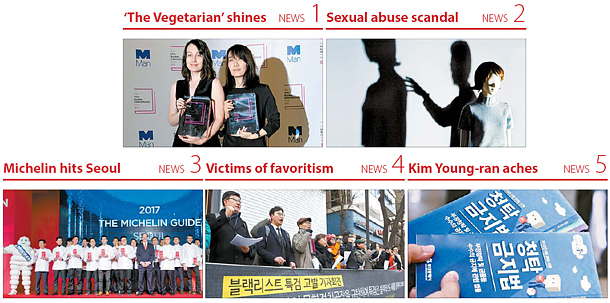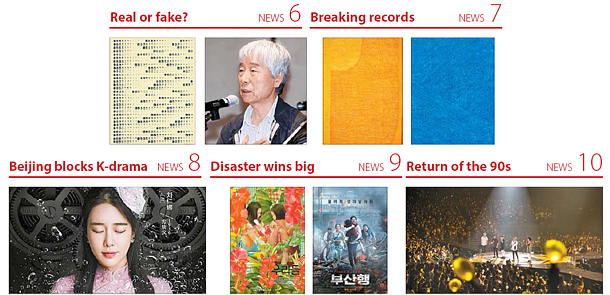Scandal and surprise lead 2016 headlines

Chun Kyung-ja’s painting “Beautiful Woman” on view at the Seoul Central District Prosecutors’ Office in Seocho-dong, southern Seoul, on Dec. 19. The prosecutors concluded the painting is authentic despite allegations by the artist herself and her descendants. In 2016, Korea’s cultural sector was dominated by a number of news stories in 2016, including various art forgery scandals. [JOINT PRESS CORPS]
And sexual violence accusations in the literature, fine art and film sectors unveiled an ugly side often hidden in the arts community.
But there was also good news, such as novelist Hang Kang’s winning of the prestigious Man Booker International Prize and the new record high price for Korean art set by Kim Whanki’s abstract paintings.
Here are the top 10 culture stories from Korea in 2016, chosen by the Korea JoongAng Daily.

In May, Korean author Han Kang won the prestigious Man Booker International Prize for “The Vegetarian.”
The three-part novel revolves around a woman who “wants to reject human brutality” and gives up eating meat.
The book, which was published in Korea in 2007, was translated by Deborah Smith. Han and Smith split the award’s £50,000 ($61,282) prize money.
Smith, who had learned that there were not many English-Korean literature translators, began learning Korean just seven years ago.
“This concise, unsettling and beautifully composed story traces an ordinary woman’s rejection of all the conventions and assumptions that bind her to her home, family and society,” chair of judges Boyd Tonkin said. “Deborah Smith’s perfectly judged translation matches its uncanny blend of beauty and horror at every turn.”
“The Vegetarian” was published in the UK in 2015 and in the U.S. in January.
A total of 155 books were submitted for the Man Booker International and shortlist included the final novel in Elena Ferrante’s Neapolitan series, “The Story of a Lost Child,” as well as Orhan Pamuk’s “A Strangeness in My Mind.” The judges’ decision was unanimous and marked the first time that a Korean won the Man Booker International Prize.
2. Sexual abuse scandal
Not long after the encouraging news about Han Kang, Korea’s literary world fell into turmoil after one sexual violence accusation after another surfaced on social media.
In October, an aspiring writer claimed on Twitter that she was forced to have sexual intercourse with poet Park Jin-seong.
This was followed by more such revelations.
That same month, an editor argued on Twitter that writer Park Bum-shin - who is famous for his 2010 book “Eungyo,” which was released as a film in 2012 - had groped a television writer at a drinking session, as well as two female fans who had attended. Around that time, a group of high school students taking a poetry class taught by poet Bae Yong-je also claimed through Twitter that he would sexually harass them. One of the students said she was raped by him.
All of them acknowledged the allegations to a certain degree.
In all of these cases, the men used their position of power to harass or assault women who looked up to them, sometimes insinuating that they should let loose and “go astray” to succeed in literature.
Allegations of sexual abuse or misogyny surfaced outside the literary set as well, in other cultural fields like fine arts and film, suggesting that the issue is deeply rooted in many parts of Korean society.
3. Michelin hits Seoul
Restaurants in Korea got a greater chance to be internationally recognized thanks to the arrival of the Michelin Guide to Seoul in November. The guide published its restaurant reviews in both Korean and English.
The globally renowned guide made by French tire company Michelin gave two restaurants specializing in Korean food, La Yeon and Gaon, its highest rating of three stars. A total 24 restaurants were awarded stars, with three restaurants given two stars.
More than half of the starred restaurants serve Korean food, either in a traditional style or a more modern one featuring a course meal more frequently seen in Western-style dining.
Many culinary experts gave mixed reviews about how the Michelin Guide valued the local dining scene as some restaurants were not widely known even to many food aficionados working in the restaurant industry.
However, since the guide book is renewed every year, many are now waiting to see if the Michelin Guide’s first impression of local restaurants will change.
This year alone, the French guide extended its presence to three cities in Asia: Shanghai, Singapore and Seoul. There are currently 2,700 restaurants worldwide with Michelin stars, and the top honor of three stars has been given to 111 restaurants.
4. Victims of favoritism
Throughout the year, left-leaning artists claimed to be the victims of favoritism due to speculation that the government was providing opportunities to a select number of creators.
In October, a newspaper disclosed about 1,500 names of artists who insisted that the Ministry of Culture, Sports and Tourism has been compiling a so-called “blacklist” since 2014 to refuse them government sponsorship.
The artists who are on the list are those said to be politically left-wing and the list, although its real existence has not been confirmed, quickly took flight online.
Cha Eun-taek, an associate of controversial presidential friend Choi Soon-sil, and a former TV commercial director, is reported to have played a major role in deciding who got support. The individuals, allegedly, lost their subsidies, or saw decreases from initial figures.
Meanwhile, some openly left-leaning artists such as singer Lee Seung-hwan and actor Jung Jin-young, who couldn’t find their names on the list that circulated online, expressed displeasure saying that they should be on it. Lee was the first to perform at a concert held at the third candlelight vigil protest against the Park Geun-hye government on Nov. 12.
It was revealed that Choi’s power was strong in the culture ministry, and former vice culture minister Kim Chong was a close aide. Kim was removed from the position Dec. 1.
5. Kim Young-ran aches
The so-called Kim Young-ran law, which prohibits the solicitation of graft, took force at the end of September, bringing a cold front to the country’s music and performing arts fields.
Although the subjects of the law are civil servants, employees of public service organizations, journalists and teachers, since it affects their immediate families as well, most Koreans have been extremely careful not to receive meals of over 30,000 won ($24.92), gifts of over 50,000 won and congratulatory money of over 100,000 won.
Since the cheapest tickets to world-class concerts and classical music performances cost well over 50,000 won, producers had to quickly find ways to attract those who usually attended shows with gifted tickets.
One of the countermeasures created was the so-called “Kim Young-ran ticket,” which lowered the prices of the cheapest tickets to less than 50,000 won.
However, critics pointed out that production companies who had relied heavily on large-scale corporate purchases, will not be able to ease the pain by just lowering the ticket prices as production costs are usually very high. Moreover, since most large-scale performances land sponsors at least a year before the show, critics pointed out that production companies will face real hardships beginning next year.

Modern and contemporary art, which many find difficult and unfamiliar, has attracted greater public attention this year after a series of bad news that included alleged forgery scandals.
Last week, prosecutors concluded that artist Chun Kyung-ja’s painting, “Beautiful Woman,” is authentic, going against allegations made by the artist herself (now deceased) and her descendants that the painting is a forgery. Still, the 25-year-old controversy may not end, as Chun’s family said they would make an appeal.
In July, the renowned artist Lee Ufan (pictured above) was summoned by police to look at 13 pieces deemed fakes by both the National Forensics Service and civilian art experts. But in a surprising turn of events, Lee was adamant that all the pieces were authentic, only fueling controversy. Lee went even further, alleging that the police had tried to coerce him into lying, which police strongly denied.
Cho Young-nam, a popular singer and painter, has been investigated by prosecutors after allegations were made in May that he sold paintings which he had another artist paint on his behalf. Last week, prosecutors asked the court to sentence Cho to one and a half years of imprisonment on the charge of fraud.
7. Breaking records
Though some forgery scandals hit the Korean art market, the record price of Korean artwork ever auctioned has been renewed three times this year - all by pioneering abstract artist Kim Whanki (1913-74).
Kim’s 1970 painting “12-V-70 #172”(pictured at left) fetched 41.5 million Hong Kong dollars ($5.3 million) at the Seoul Auction’s Hong Kong sale in Nov. 27.
It broke the former record of both Kim and Korean art set by his 1972 abstract painting “Untitled 27-VII-72 #228”(right in the photo) which fetched 5.4 billion won ($4.66 million) at K Auction’s Seoul sale on June 28.
Now, the five most expensive pieces of Korean art ever auctioned are all abstract paintings by Kim, the so-called dot paintings he made during his so-called New York period (1963-1974).
Experts cited the importance of Kim in the Korean art history as abstract painter preceding dansaekhwa, or Korean monochrome paintings; the overseas extension of the Korean art market helped by the global boom of dansaekhwa in recent years, and the management of Kim’s works after his death, which helped the artist be relatively free from forgery scandals.
8. Beijing blocks K-drama
Hallyu, or the Korean Wave, has been hit hard this year by what is believed to be Beijing’s unofficial restrictions of the Korean entertainment industry following Seoul’s decision in July to deploy the U.S.-led Terminal High Altitude Area Defense (Thaad) system.
Despite the immense popularity of Hallyu properties such as the mega-hit drama “Descendants of the Sun,” which aired from February to April, Korean content suddenly faced limitations in China after the rise of diplomatic tensions between Seoul and Beijing following the Thaad decision. Also hit hard were Korean celebrities, who have been restricted from appearing on Chinese shows.
Korean actress Yoo In-na of the 2014 hit drama “My Love from the Star,” for example, filmed a 28-episode drama series in China, but was cut out of the blue a month before airing. The 34-year-old, pictured above, was replaced by a Taiwanese actress.
Similarly, producer Shin Woo-chul of the 2011’s “Secret Garden” was set to film a jointly produced drama with Chinese streaming site Youku Tudou. The firm suddenly informed its Korean partners a month before shooting began that it had postponed production indefinitely.
9. Disaster wins big
Two notable achievements in this year’s Korean movie industry are the success of disaster films and the accomplishments of female directors.
A number of this year’s hit movies fall under the disaster genre. Korea’s first big-budget zombie movie, “Train to Busan,” right in the photo above, became the first and the only film this year to exceed the 10 million tickets sold mark. Although “Tunnel” couldn’t quite reach that point, it was also popular enough to sell more than 7.1 million tickets, dominating the box office for 28 consecutive days. Another well-received disaster film is the CGI-filled “Pandora” that maintained the top spot for longer than two weeks until the crime-action blockbuster “Master” hit theaters a week ago.
Also to be noted is the success of female directors. Filmmaker Yoon Ga-eun’s “The World of Us,” right in the photo above, was invited to the 66th Berlin International Film Festival and he was honored with a rookie director award at the 37th Blue Dragon Awards.
Other notable films directed by female directors in 2016 are Lee Kyoung-mi’s “The Truth Beneath,” E.Oni’s “Missing,” Lee Hyun-ju’s “Our Love Story” and Hong Ji-young’s “Will You Be There?”
10. Return of the 90s
Old-school K-pop idol acts have seen a resurgence in popularity and are making headlines thanks to growing nostalgia for music popular in the 90s.
Although first generation idol group Shinhwa has been leading the resurgence with a string of regular album releases since 2012, the nostalgia effect has been in full since the explosive popularity of variety music shows such as MBC’s “I Am a Singer,” “King of Mask Singer” and KBS2’s “Immortal Songs,” where singers pay tribute to older artists by covering their songs.
Additionally, the sudden reunion of K-pop pioneers Sechs Kies, seen in the photo above, and their signing to prominent record label YG Entertainment played a large role in re-igniting interest for these artists. Riding this new wave of attention, Sechs Kies unveiled their first album in 16 years to positive reception, while girl group S.E.S unveiled their first single in 14years in order to kick off plans to celebrate their 20th anniversary next year.
Veteran K-pop group NRG also confirmed plans for a reunion next year, while former H.O.T member Kangta also expressed interest in a reunion.
BY SPECIAL REPORT TEAM [symoon@joongang.co.kr]










with the Korea JoongAng Daily
To write comments, please log in to one of the accounts.
Standards Board Policy (0/250자)